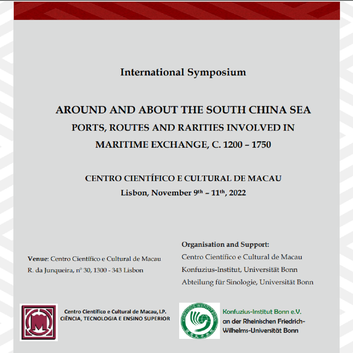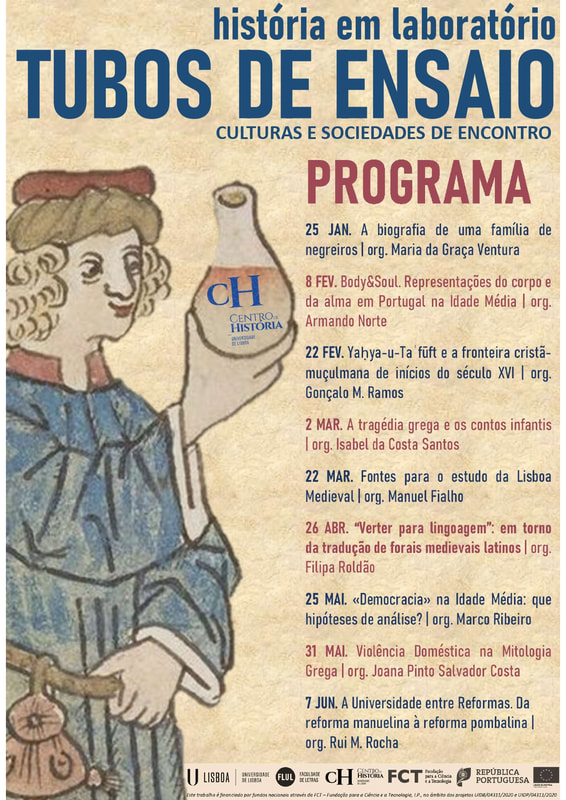| International Symposium - Around and About the South China Sea: Ports, Routes and Rarities Involved in Maritime Exchange, c. 1200-1750 Centro Científico e Cultural de Macau 9-11 de novembro de 2022 Organização Centro Científico e Cultural de Macau Konfuzius-Institut (Universität Bonn) Abteilung für Sinologie (Universität Bonn) Luís Filipe Barreto será keynote speaker e apresentará a conferência de encerramento intitulada "From Dangerous Outsider to Informal Partner: The Portuguese Connection in the Ming South China Sea". Este simpósio conta ainda com a participação dos investigadores do CH-ULisboa Elisabetta Colla e Jorge Semedo de Matos. |
Luís Filipe Barreto, "From Dangerous Outsider to Informal Partner: The Portuguese Connection in the Ming South China Sea"
Five hundred years ago, in 1522 (August 4 to 18), in the South China Sea Pearl River Delta, the Portuguese and Chinese state powers were in "full war"/"total guerra" (João de Barros, 1563). Four hundred years ago, in 1622 (June 21 to 24), in the South China Sea Macau Island, in the Pearl River Delta, Dutch and Portuguese military powers were also in full war. In 1522, the Portuguese were defeated in the first naval war between Western and Chinese maritime powers. In 1622, the Dutch lost the first great battle between westerners in the South China Sea. Five hundred years ago, in the Ming South China Sea, the Portuguese/“folangji” were regarded as dangerous outsiders. Four hundred years ago, the Portuguese defended Macau, an open Sino-Portuguese international city and a port on a Chinese island of the Pearl River Delta, Guangdong province, from the attack of a European naval power. At this time, the Portuguese of Macao were less "folangji" and more people that had arrived from the western sea, Portugal/"Pulidujia" (1565). Between 1621 and 1647, Portuguese military expeditions from Macau are found in the Great Wall supporting the Ming against the Manchu. How could this change happen? What was the process that led the Portuguese into the Ming South China Sea? With the Cape Route, the Portuguese arrived in the Indian Ocean/Calicut in 1498. This marks the beginning of the reception of some information about the South China/Guangdong province, Zeng He maritime expeditions, and Melaka as the gate of the maritime trade of Ming China; it was also the beginning of the consumption of Chinese commodities. The first step of the process of connection and accommodation. The purpose of this conference is to analyze some of the central features of this process.
Elisabetta Colla, “Mazu, Macau and Maritime Exchange: The Spiritual World of Seafarers”
In line with topics already studied and presented in the monograph The mazu cult: historical studies and cross-cultural comparisons (2017), this paper aims to revisit the centrality of Mazu goddess as part of a religious system aimed at negotiating the relationship between the thalassographic and the human worlds. In the past, as well in the present, taking the Sea has meant facing perilous waters, the danger of sinking and the eventuality of not getting back home. For many reasons, not least the attack from pirates, sailing along the South China Sea coast in direction of the Southeast Asia, as well as in other long-distance voyages, has being considered by seafarers an unpredictable journey. In this context, one can observe the rise of local cults aimed at respond to the diverse seafarer’s request for protection, suppliant’s appeal addressed to diverse local gods and goddess, among which Mazu has being probably considered the most powerful.
Jorge Semedo de Matos, “Portuguese and Spanish Rutters and Routes Related to the China Sea after Ferdinand Magellan’s Voyage”
The arrival of Ferdinand Magellan in the Philippines in 1521 opened a sea route connecting Central America and the Philippines, which gained a definitive expression when Lopez de Legaspi established
himself on these islands, and Andres de Urdaneta found a sea route back to America. Especially after Legazpi's establishment in Manila on the island of Luzon in 1571, American silver entered the circuit of Southeast Asian trade. Manila's connections with China were immediate. At the beginning of the next century, the Portuguese, established in Malacca and Macau, entered this circuit in a very close partnership with the Spanish. This placed the two Iberian peoples on the trade routes that linked the three cities (Malacca, Manila and Macau) and their connection through the Pacific to Central America. New rutters from these routes were written in Portuguese and Castilian languages and related to their navigation technique. I will speak about these rutters and itineraries in my paper.
















 Feed RSS
Feed RSS
